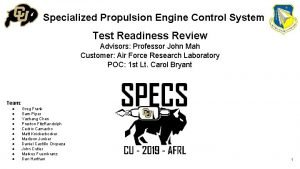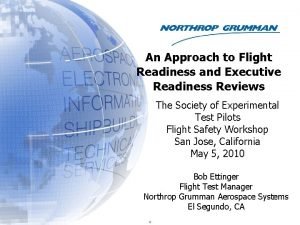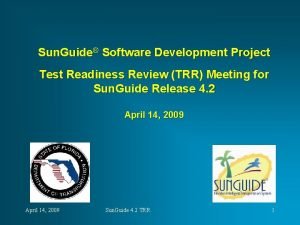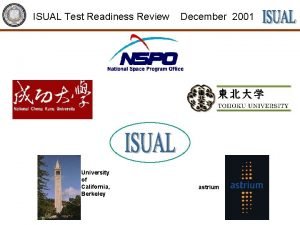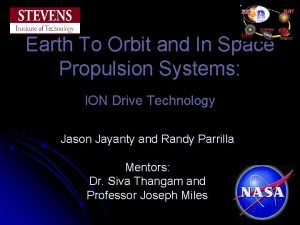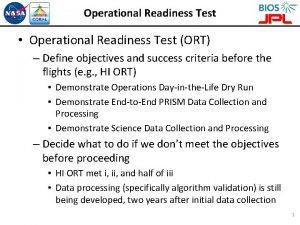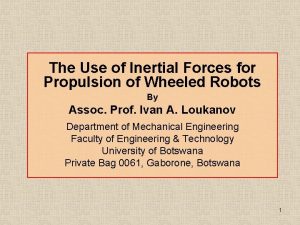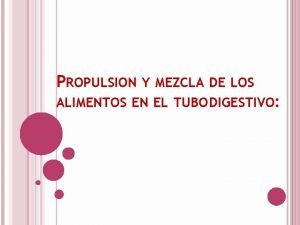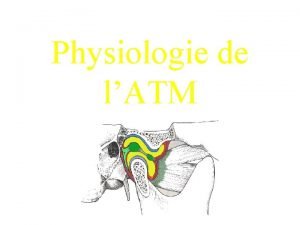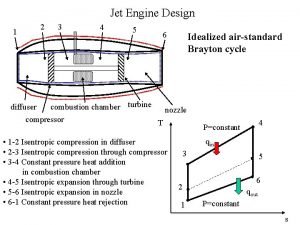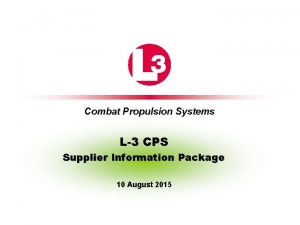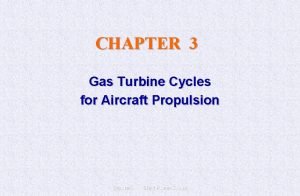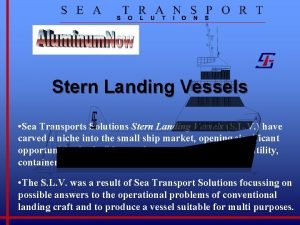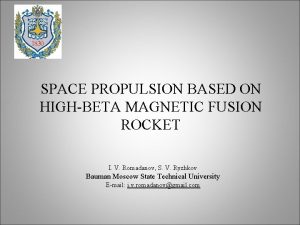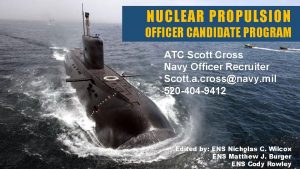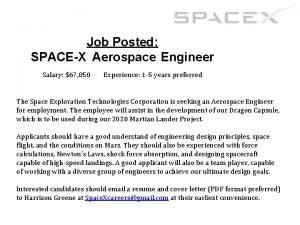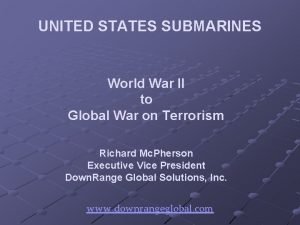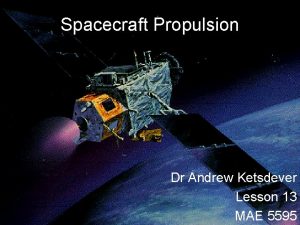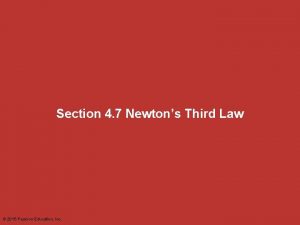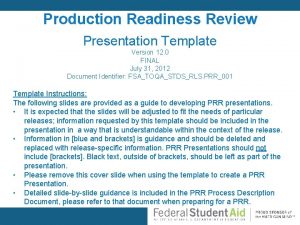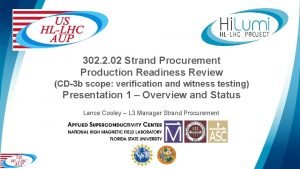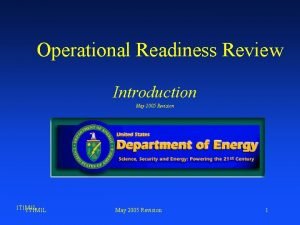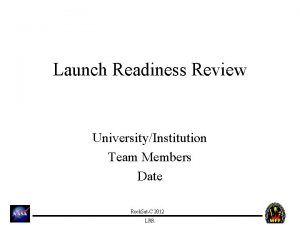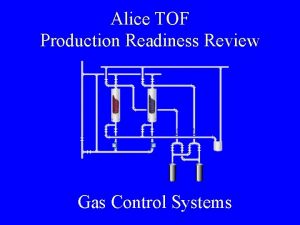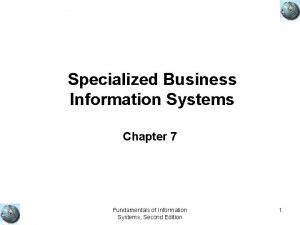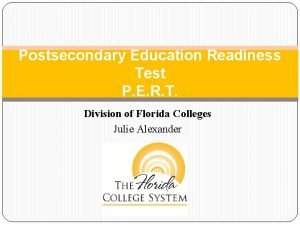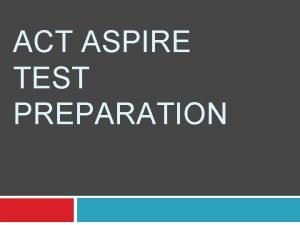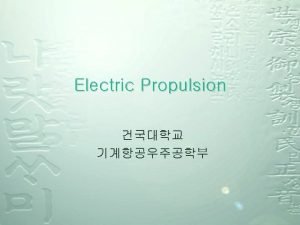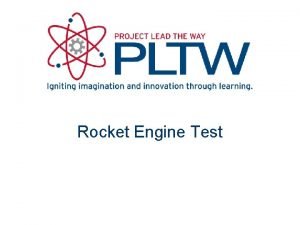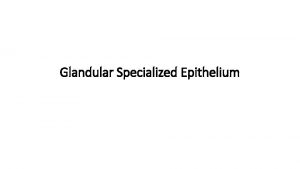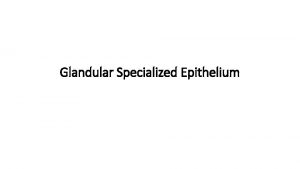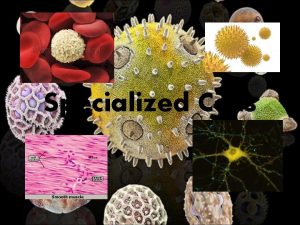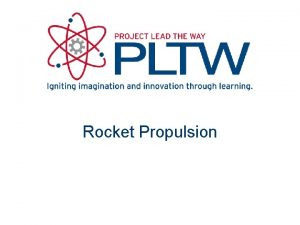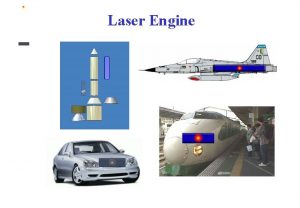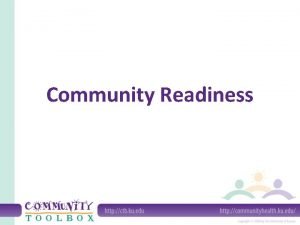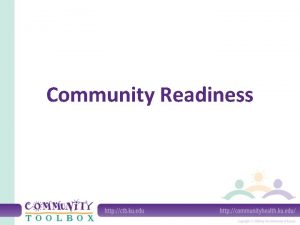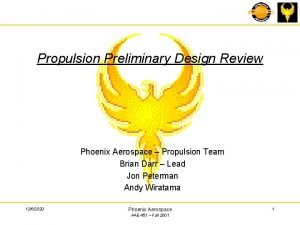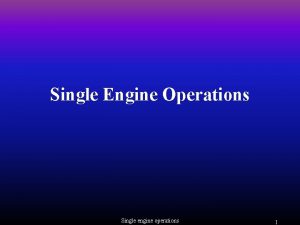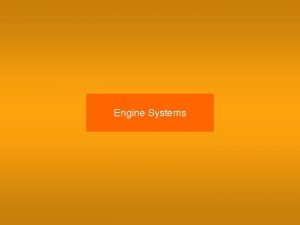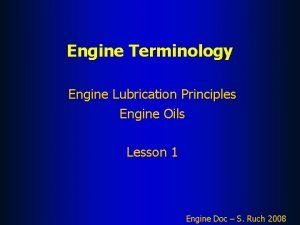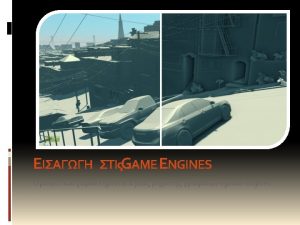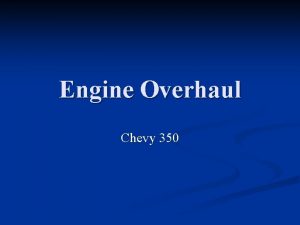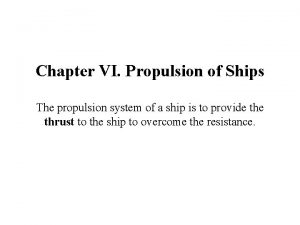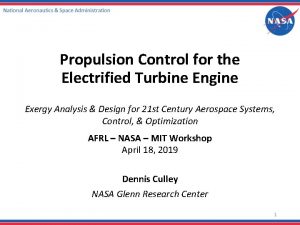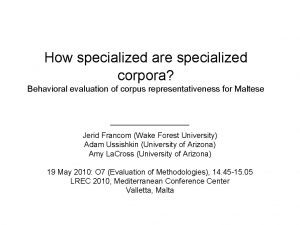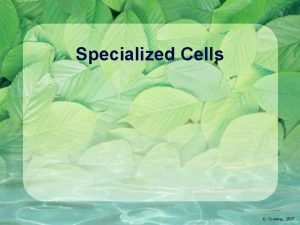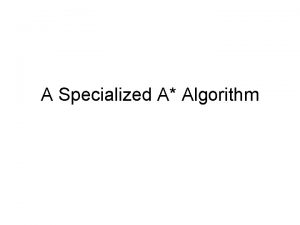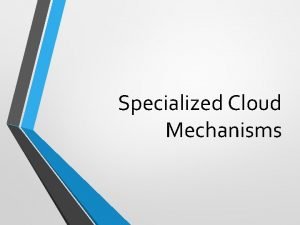Specialized Propulsion Engine Control System Test Readiness Review
























![References [1] Alex Bertman, Jake Harrell, Tristan Isaacs, Alex Johnson, Matthew Mc. Kernan, T. References [1] Alex Bertman, Jake Harrell, Tristan Isaacs, Alex Johnson, Matthew Mc. Kernan, T.](https://slidetodoc.com/presentation_image_h/fb44cd4ba63cdbe1bc3ec3eead788e2c/image-25.jpg)






- Slides: 31

Specialized Propulsion Engine Control System Test Readiness Review Advisors: Professor John Mah Customer: Air Force Research Laboratory POC: 1 st Lt. Carol Bryant Team: ● ● ● Greg Frank Sam Piper Yuzhang Chen Preston Fitz. Randolph Cedric Camacho Matt Knickerbocker Madison Junker Daniel Castillo Oropeza John Cutler Markus Fuernkranz Dan Harthan 1

Problem Statement ● Increase Thrust-to-Weight (T/W) Ratio of the Jet. Cat P 90 -RXi Engine ● The engine must run for an ‘extended period of time’ as defined by CONOPS Motivation ● The United States Air Force (USAF) would like to implement a T/W increasing modification into their fleet of Unmanned Aerial Vehicles (UAV) ● Ideal solution would be low cost and easy to implement with minimal modification to existing engine 2

Overview Schedule Testing Budget 3

Concept of Operations (Mission Profile) 4

Levels of Success 5

Levels of Success 6

Functional Block Diagram + 7

Critical Project Elements Designation CPE Critical Characteristics CPE-2. 1 Engine Control Loop (ECM) Control algorithms are inherently complex and require additional validation prior to implementation. Certification through the use of an engine analog is necessary. CPE-2. 2 Engine Sensors (ECM) Coordination of engine sensor data acquisition with its utilization by the processor is critical. Without accurate sensor data, the engine cannot safely operate. CPE-3 Communication from User to Engine (ECU) During initial testing and product development user oversight will verify safe operation and monitor for anomalies. 8

Scheduling Overview Schedule Testing Budget 9

Project Planning PCB Final Design TRR Engine Testing with V 2. 0 SPECS Electronics SPECS V 3. 0 Engine Test SFR End User Packaging & Documentation

Testing Overview Schedule Testing Budget 11

Electronics Testing Flowchart PCB Production Microscope Inspection Model Verification Power On FLIR Program FLIR Calibration Sensors Power FLIR Verification Simulation Test-Bed FLIR Data Acquisition Engine Run FLIR 12

Electronics Testing Thermal Results V 1. 0 V 2. 0 Corrections: Higher current 5 V linear regulator, moved battery measure circuit to ECM, TVS diode for MOSFETS, larger flyback diodes, larger gauge wire for motors and ignition system. Corrections: Larger flyback diodes again, signal resistors need space, locate programming header toward centerline, USB pinout correction on ECU, heatsinks for controller components. 13

Electronics & Simulation Testing ● SCOPE ○ Install SPECS ECU and ECM. Command from GUI and simulation. Measure the simulation response. Develop initial controller setpoints for first engine start. ○ Connect fuel pump ECM output to input DAQ and RPM and EGT inputs on ECM to simulator output DAQ. Run all system commands from GUI to simulate engine run parameters. Verify ECM output. ● PURPOSE ○ Determine conservative operation expectations for first engine start. ○ Verify safety functions and estimated max EGT and RPM. ● STATUS ○ Electronics testing complete, simulation requires verification. PWM maximum of 13. 7% duty cycle controller output maximum to prevent the engine from receiving enough fuel to exceed 100, 000 RPM, allowing for transient values. ○ Selected a maximum RPM command value of 70, 000 for first test, predicted steady state EGT of 638℃. ● SAFETY ○ Triplicate limits: commanded fuel pump PWM, commanded RPM, sensed RPM. 14

Simulation Testing Results ● ● ● Simulation dynamic response closely mimics that of the actual engine. Limited data requires further analysis of data obtained after incorporating SPECS system. Dynamic engine response data from previous years defines SPECS engine acceleration limits. Result: SPECS acceleration limits set to not exceed what was observed by stock engine performance. 15

Error Propagation ● ● Inlet mass flow used to validate thermodynamic model. Sensor calibrated using ITLL Wind tunnel. ○ Max Error: 2. 8% ○ Typical Error: 2% - Consistent with Mfr. ● Fuel flow to ECM PWM relationship used to ensure engine control limits are not exceeded and provide initial estimates for RPM/EGT. Fuel flow determined using the same methodology as the original fuel flow to pump voltage relationship. ○ Max Error: 2. 2% ○ Typical Error: 1. 4% ■ Resultant Max Engine RPM Error: 2375 RPM. ● 16

Integrated Engine Run ● SCOPE ○ Install SPECS system on Jet. Cat P 90 RXi. ○ Using controller limits previously determined: command start sequence, tune to achieve stable starting sequence. ○ Performed on site at EDEP utility plant. ● PURPOSE ○ Initial programmed start sequence can be varied to achieve stable conditions for combustion. Determine fixed start sequence tuning variables and timing. ○ Validate starting sequence and combustion parameters for starting engine. ● STATUS ○ First test scheduled for Monday, March 4 th, followed by weekly tests ○ Engine operation limits gradually increased as control scheme is refined. ● SAFETY ○ Set low controller outputs initially, engine operation limited to achieve start RPM. Verified functional E-Stop button and controller. 17

Upcoming Engine Test Sequence March 4 th Overview: Determine start sequence using SPECS Electronics & verify simulation March 11 th March 18 th Engine Run Limited (33 K 70 K) Limit and Safety Testing Overview: Perform step response testing from 33 k to 70 k RPM for control constants. Overview: Continue step response testing from 70 k-130 k RPM. Test E-Stop, Test OP limits and safety. March 25 th Overview: Increase to 140 K RPM, Implement Aerospike, Integrate SPECS Nozzle 18

Engine Run Safety ● Fire Safety ○ Fire department & CUPD notified ○ Class B fire extinguisher + trained users ● Physical Safety ○ PPE, test procedures, blast shield, barriers, distance, limited personnel ● Chemical Safety ○ PPE, absorbent materials, drip tray 10 ft 20 ft Danger Zone Electronics Safeties ○ Software limits/stops, emergency shut-offs 10 ft ● CU East District Powerplant N 19

Aerospike & Nozzle Testing ● SCOPE ○ Inserting aerospike into the nozzle flow to alter exit area and static pressure ○ Test stand (with engine), actuator, spike, and mount ○ Procedures: Take thrust and pressure data at different effective exit areas at 140 K RPM ● PURPOSE ○ Allows for dynamic tuning of nozzle, removes requirement of fabrication of multiple nozzles. ○ See an increase in thrust from load cell, and exhaust static pressure ambient. ○ Validates exit area of nozzle for higher thrust. ● STATUS ○ Need to complete actuator calibration (in progress) ○ Need a fully functional running engine, start-up sequence needed first ● SAFETY ○ Heat gun and pressure force testing, FLIR monitoring 20

Budget Overview Schedule Testing Budget 21

Budget Status Purchased/Received/Manufactured: ● ● Electronics: ○ PCBs: V 1. 0 -V 2. 0 ○ PCB Components ○ E-Stop ○ Arduino ○ Battery & Charger Mechanical/Test Stand ○ Nozzle (Being Manufactured) ○ Aerospike ○ x 2 Jet. Cat P 90 Engines ○ Fire Extinguisher ○ Fuel System ○ First Aid Kit ○ Blast Shield Pending Purchases: 2% ● ● ECU & ECM V 3. 0 (5 Day Lead) AIAA registration ($50/person) New engine P-100 (2 -4 Weeks) Presentation Poster Total Remaining Cost: 27. 1% $250 $100 $2500 $100 $2950 22

Budget Status (Visual) 23

Questions? 24
![References 1 Alex Bertman Jake Harrell Tristan Isaacs Alex Johnson Matthew Mc Kernan T References [1] Alex Bertman, Jake Harrell, Tristan Isaacs, Alex Johnson, Matthew Mc. Kernan, T.](https://slidetodoc.com/presentation_image_h/fb44cd4ba63cdbe1bc3ec3eead788e2c/image-25.jpg)
References [1] Alex Bertman, Jake Harrell, Tristan Isaacs, Alex Johnson, Matthew Mc. Kernan, T. R. Mitchell, Nicholas Moore, James Nguyen, Matthew Robak, Lucas Sorensen, Nicholas Taylor, “Air-breathing Cold Engine Start Manufacturing Status Review”, 2017, Retrieved Jan 25, 2019. [2] Andrew Sanchez, Tucker Emmett, Corrina Briggs, Jared Cuteri, Grant Vincent, Alexander Muller, “SABRE Manufacturing Status Review’’, 2016. Retrieved Jan 25, 2019. [3] “Turbine Data Sheet. ” Jet. Cat, July 14 2015. Web. September 4, 2018, from https: //www. chiefaircraft. com/pdf/jetcat-data. pdf [4] “Jet. Cat RX Turbines with V 10 ECU. ” Jet. Cat, n. d. Web. September 4, 2018, from https: //studylib. net/doc/18303934/jetcat-rx-turbines-with-v 10 -ecu [5] “ATmega 328/P Datasheet. ” Atmel, November 2016. Web. September 4, 2018, from http: //ww 1. microchip. com/downloads/en/devicedoc/atmel-42735 -8 -bit-avr-microcontroller-atmega 328 -328 p_datasheet. pdf [6] “ATmega 640/1281/2560/2561 Datasheet. ” Atmel, February 2014. Web September 4, 2018, from http: //ww 1. microchip. com/downloads/en/devicedoc/atmel-2549 -8 -bit-avr-microcontroller-atmega 640 -1281 -2560 -2561_datasheet. pdf [7] Daniel Alonzo, Alex Crocker, Eric James, John Kingston III, “Design and Manufacturing of a Miniature Turbojet Engine”, Worchester Polytechnic Institute, March 23, 2018, retrieved 20 October 201 25

Backup Slides 26

Mass Flow Inlet Pitot Tube New Nozzle Mass Flow Inlet Design 27

Aerospike Thermal Testing 28

Starter Inlet ● Status -Design complete and starter inlet printed with Formlabs class printer using high strength FLGPCLR 02 Resin ● Concerns -Stall torque of starter motor -Potential flow disturbance ● Mitigation Strategies -Structural analysis -Testing 29

Test Stand Component Layout All sensors and DAQs have been acquired. - Requires calibration certification New Nozzle 30

Software Manufacturing Overview : In working condition : In development
 Test readiness review
Test readiness review Flight readiness review
Flight readiness review Test readiness review
Test readiness review Test readiness review presentation
Test readiness review presentation Siva de scalzo
Siva de scalzo Operational readiness presentation
Operational readiness presentation Inertial propulsion drive
Inertial propulsion drive Propulsión en el sistema digestivo
Propulsión en el sistema digestivo Condyle travaillant et non travaillant
Condyle travaillant et non travaillant Jet engine diffuser
Jet engine diffuser Cps supplier
Cps supplier Turbojet vs turbofan
Turbojet vs turbofan Stern landing vessel propulsion
Stern landing vessel propulsion Magnetic space propulsion
Magnetic space propulsion Nuclear propulsion officer
Nuclear propulsion officer Spacex chemical engineer salary
Spacex chemical engineer salary Nuclear propulsion
Nuclear propulsion Propellantless propulsion
Propellantless propulsion Nuclear thermal propulsion
Nuclear thermal propulsion Squid use jet propulsion for rapid escapes
Squid use jet propulsion for rapid escapes Internal combustion vs external combustion
Internal combustion vs external combustion Production readiness review
Production readiness review Chapter 6: career readiness
Chapter 6: career readiness Supplier readiness review
Supplier readiness review Taacs tamworth
Taacs tamworth Launch readiness review
Launch readiness review Launch readiness review
Launch readiness review Production readiness review
Production readiness review Specialized information systems examples
Specialized information systems examples Postsecondary education readiness test
Postsecondary education readiness test Workplace readiness skills for the commonwealth
Workplace readiness skills for the commonwealth Sahs aspire
Sahs aspire
